Pre-cooked prime rib offers a convenient solution for busy households‚ simplifying meal preparation without compromising on flavor and quality․ Perfect for special occasions or everyday meals‚ it provides ease and delicious results․

What is Pre-Cooked Prime Rib?
Pre-cooked prime rib is a convenient and flavorful option for home cooks‚ offering tender‚ juicy meat with minimal preparation․ Made from a prime rib roast‚ it is slow-cooked to enhance its rich‚ beefy flavor and retain moisture․ This option is ideal for busy individuals seeking to save time while enjoying a high-quality meal․ Pre-cooked prime rib is typically seasoned and cooked to perfection‚ allowing it to be quickly reheated at home․ It’s a perfect solution for special occasions or everyday meals‚ providing the luxury of a restaurant-quality dish without the hassle of extensive cooking time․
Benefits of Using Pre-Cooked Prime Rib
Using pre-cooked prime rib offers numerous advantages‚ particularly for those with busy schedules․ It saves significant time‚ as it eliminates the need for lengthy preparation and cooking․ The meat is already tender and flavorful‚ ensuring a consistent result every time․ Additionally‚ pre-cooked prime rib reduces the risk of overcooking‚ making it a stress-free option for home cooks․ It’s also versatile‚ allowing for easy reheating in various methods such as the oven‚ stovetop‚ or microwave․ This convenience makes it ideal for hosting gatherings or enjoying a gourmet meal without the effort of cooking from scratch․ It’s a practical choice for balancing taste and time constraints․
Choosing the Right Pre-Cooked Prime Rib
Selecting the right pre-cooked prime rib involves considering size‚ quality‚ and packaging․ Opt for a well-marbled cut for tenderness and flavor‚ ensuring it suits your serving needs․
Factors to Consider When Selecting Pre-Cooked Prime Rib
When selecting pre-cooked prime rib‚ consider size based on servings needed‚ ensuring it fits your guest count․ Look for even marbling‚ as it enhances tenderness and flavor․ Check packaging for freshness and vacuum-seal quality to prevent spoilage․ Opt for prime or choice grades for superior quality․ Consider pre-seasoned options for convenience‚ or unseasoned if you prefer custom flavors․ Always check the expiration date and storage conditions to ensure safety․ These factors ensure you choose a prime rib that meets your expectations for taste‚ texture‚ and presentation․
Understanding Labels and Packaging
Understanding labels and packaging is crucial for selecting high-quality pre-cooked prime rib․ Look for labels indicating “pre-cooked” or “fully cooked” to ensure it’s ready to reheat․ Check for “USDA-inspected” or “grade” designations‚ which guarantee quality standards․ Packaging should be vacuum-sealed or airtight to maintain freshness and prevent contamination․ Avoid products with damaged or torn packaging‚ as this can compromise safety․ Some packages may include seasoning packets or au jus for added flavor․ Always check the “use by” or “freeze by” dates to ensure the product is fresh․ Proper labeling and packaging ensure safety‚ quality‚ and convenience when preparing pre-cooked prime rib․

Safe Handling and Storage
Proper refrigeration and storage are essential for maintaining the quality and safety of pre-cooked prime rib․ Always store it at 40°F or below to prevent bacterial growth․
Proper Refrigeration Techniques
Pre-cooked prime rib should be stored in the refrigerator at a consistent temperature below 40°F to prevent bacterial growth․ Place the prime rib in its original packaging or a sealed‚ airtight container to maintain moisture and flavor․ If the packaging is opened‚ transfer the meat to a food-safe container with a tight-fitting lid․ Ensure the meat is kept away from strong-smelling foods‚ as it can absorb odors easily․ Use within 3 to 5 days for optimal quality․ Always check for signs of spoilage‚ such as an off smell or slimy texture‚ before consuming․ Proper refrigeration ensures safety and preserves the prime rib’s tenderness and taste․
Freezing Guidelines for Pre-Cooked Prime Rib
Pre-cooked prime rib can be frozen to extend its shelf life‚ maintaining quality for up to 3 months․ Wrap the prime rib tightly in plastic wrap or aluminum foil‚ then place it in a freezer-safe bag to prevent freezer burn․ Ensure the meat is completely cooled before freezing to avoid ice crystal formation‚ which can affect texture․ When freezing‚ portioning the prime rib into smaller sections can make thawing and reheating more convenient․ Label the packaging with the date and contents for easy identification․ Freezing is an excellent way to preserve the prime rib’s flavor and texture for future meals without compromising quality․
Thawing Pre-Cooked Prime Rib
Thawing pre-cooked prime rib requires careful planning to ensure food safety․ Refrigerator thawing is recommended for even thawing‚ while cold water thawing is faster․ Avoid direct heat to prevent bacterial growth and maintain quality․
Recommended Thawing Methods
For safe and effective thawing‚ pre-cooked prime rib can be thawed in the refrigerator‚ in cold water‚ or in the microwave․ Refrigerator thawing is the safest method‚ allowing even thawing over several hours․ Place the prime rib in a leak-proof bag on the middle or bottom shelf to prevent cross-contamination․ Cold water thawing is faster‚ requiring a sealed bag and periodic water changes․ Microwave thawing is the quickest but requires immediate cooking afterward․ Always pat dry the meat after thawing to remove excess moisture․ Avoid thawing at room temperature to prevent bacterial growth․ Proper thawing ensures optimal flavor and texture when reheating․
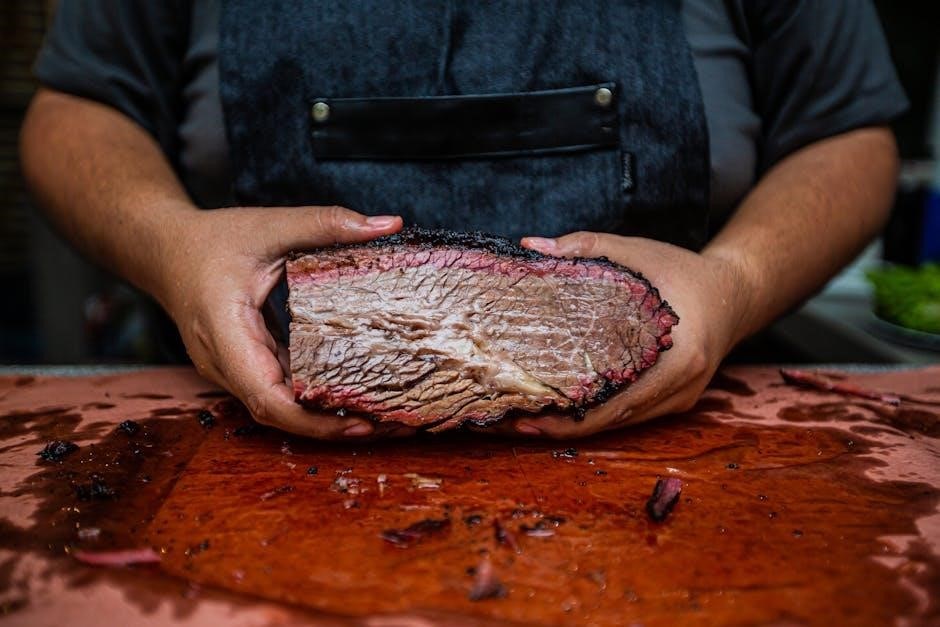
Thawing Time Estimates
Thawing time for pre-cooked prime rib varies based on the method․ In the refrigerator‚ it typically takes 6-24 hours‚ depending on size․ Cold water thawing is faster‚ requiring about 30 minutes to 2 hours per pound․ Microwave thawing is the quickest‚ taking 3-4 minutes per pound‚ but requires immediate cooking․ For smaller cuts‚ thawing times are shorter‚ while larger roasts may need several hours․ Always plan ahead to ensure the meat thaws evenly․ Pat dry the prime rib after thawing to remove excess moisture․ Proper thawing ensures the meat reheats evenly and retains its tenderness and flavor․ Timing varies‚ so monitor closely for safety and quality․

Reheating Pre-Cooked Prime Rib
Reheating pre-cooked prime rib is a convenient way to enjoy a delicious meal without extensive preparation․ It ensures tender‚ flavorful results every time‚ perfect for any occasion․
Oven Reheating Instructions
Reheating pre-cooked prime rib in the oven is a popular method for achieving tender‚ flavorful results․ Preheat your oven to 300°F (150°C)․ Place the prime rib in a roasting pan‚ adding a small amount of liquid such as au jus or broth to maintain moisture․ Cover the meat with foil to prevent drying out․ Reheat for about 20-25 minutes per pound‚ or until the internal temperature reaches 130°F to 135°F (54°C to 57°C) for medium-rare․ Let the prime rib rest for 10-15 minutes before slicing to ensure juiciness․ This method ensures a delicious‚ stress-free meal perfect for any occasion․
Stovetop Reheating Methods
Stovetop reheating is a great way to warm pre-cooked prime rib while maintaining its tenderness and flavor․ Start by placing the prime rib in a large skillet or Dutch oven․ Add a few tablespoons of liquid‚ such as beef broth‚ au jus‚ or even water‚ to the pan․ Cover the skillet with a lid to trap heat and moisture․ Heat over medium-low heat‚ allowing the prime rib to warm gradually․ Use a meat thermometer to ensure the internal temperature reaches 130°F to 135°F (54°C to 57°C) for medium-rare․ This method ensures even heating and prevents drying out‚ delivering a deliciously reheated prime rib․
Slow Cooker Reheating Options
Reheating pre-cooked prime rib in a slow cooker is an ideal method for maintaining moisture and flavor․ Place the prime rib in the slow cooker‚ adding a cup of au jus or beef broth․ Cover and set to low heat for 2-3 hours or high heat for 1-2 hours․ This gentle reheating ensures the meat stays tender and juicy․ For extra flavor‚ add garlic‚ herbs‚ or spices to the liquid․ The slow cooker’s even heat distribution prevents overcooking‚ making it perfect for a hands-off‚ stress-free reheating process that delivers a perfectly warmed prime rib every time․
Microwave Reheating Tips
Microwave reheating is a quick and convenient method for pre-cooked prime rib‚ though it requires careful attention to avoid uneven heating․ Place the prime rib on a microwave-safe dish‚ cover it with a microwave-safe lid or plastic wrap to retain moisture․ Heat on medium power in short intervals‚ checking the internal temperature with a meat thermometer․ Aim for 130°F to 135°F for medium-rare․ Add a splash of au jus or beef broth to enhance flavor and moisture․ Be cautious not to overcook‚ as this can dry out the meat․ Let it rest for a few minutes before serving․ While fast‚ microwaving is best for smaller portions‚ as larger cuts may not heat evenly․
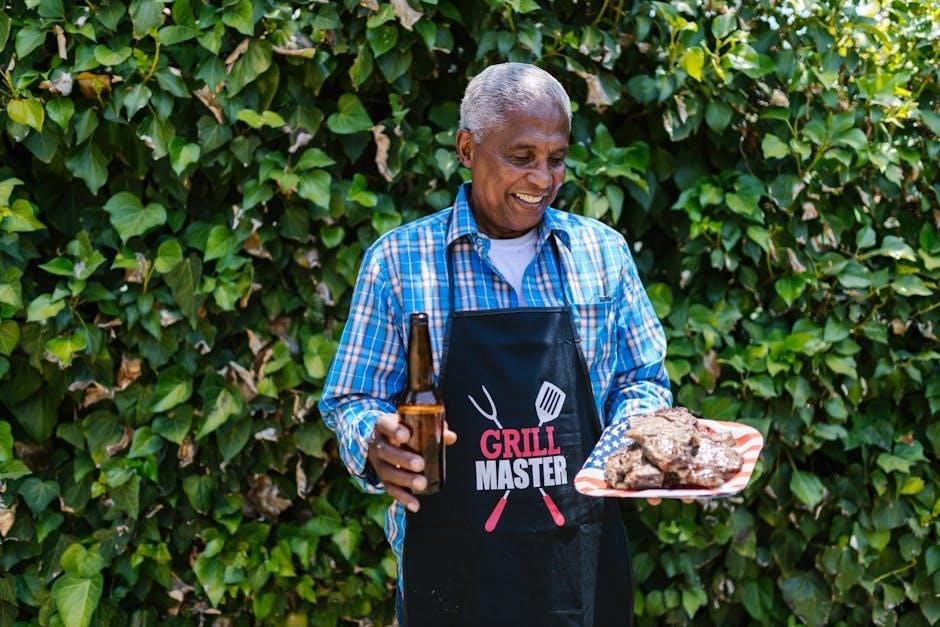
Enhancing Flavor and Texture
Season with aromatic spices and herbs‚ and let the prime rib rest before serving to ensure juiciness and optimal texture‚ enhancing the overall dining experience․
Seasoning and Spices for Pre-Cooked Prime Rib
Elevate the flavor of pre-cooked prime rib with a blend of aromatic spices like garlic powder‚ paprika‚ and thyme․ A rub of kosher salt‚ black pepper‚ and rosemary adds depth․ For a savory twist‚ mix in onion powder and cayenne pepper․ Allow the seasonings to infuse by letting the prime rib sit at room temperature for 30 minutes before reheating․ This ensures the spices penetrate evenly‚ enhancing the meat’s natural richness without overpowering it․ Experiment with different combinations to find your perfect balance of flavors‚ making each dish uniquely delicious and memorable․
Using Au Jus for Added Flavor
Au jus is a flavorful liquid gold that enhances the richness of pre-cooked prime rib․ Made from the meat’s natural juices‚ it adds moisture and depth․ Serve the prime rib in a pool of au jus or spoon it over the meat during reheating․ For extra richness‚ mix in a splash of red wine or beef broth․ Simmer the au jus with garlic and herbs to intensify its flavor․ This step ensures the prime rib stays tender and juicy‚ while the au jus infuses a savory‚ umami taste․ It’s a simple yet impactful way to elevate your dish to restaurant quality․
Resting the Meat for Optimal Juiciness
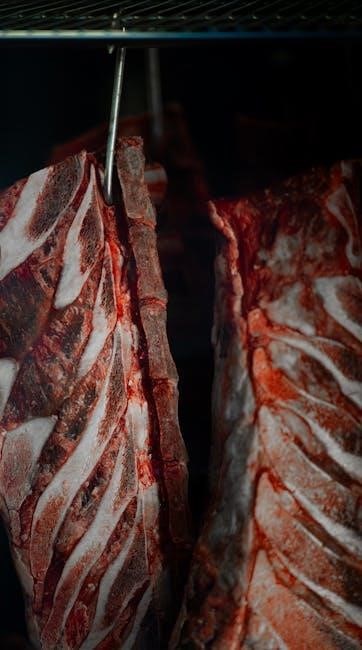
Resting pre-cooked prime rib is a crucial step to ensure maximum juiciness and flavor retention․ After reheating‚ allow the meat to rest for 10-15 minutes before slicing․ This resting period lets the juices redistribute evenly‚ preventing them from escaping when the meat is cut․ Cover the prime rib loosely with foil to retain heat without trapping steam‚ which can make the meat soggy․ Patience during this step is key‚ as it ensures a tender and juicy final product․ Proper resting enhances the overall dining experience‚ making the prime rib more enjoyable and satisfying for everyone at the table․
Serving Suggestions
Pre-cooked prime rib is versatile‚ perfect for family dinners‚ holidays‚ or casual gatherings․ Its convenience ensures a satisfying meal with minimal effort‚ pairing well with various sides․
Traditional Side Dishes for Prime Rib
Classic sides like mashed potatoes‚ roasted vegetables‚ and Yorkshire pudding are timeless pairings for pre-cooked prime rib․ These dishes complement the rich flavor of the meat perfectly․ Mashed potatoes soak up the au jus beautifully‚ while roasted Brussels sprouts or asparagus add a delightful contrast in texture․ Yorkshire pudding‚ a traditional British favorite‚ offers a light‚ airy contrast to the hearty prime rib․ For a well-rounded meal‚ consider adding a simple green salad or sautéed mushrooms․ These traditional options ensure a satisfying and flavorful dining experience that aligns with the comforting nature of prime rib․
Modern Twists and Creative Pairings
For a contemporary take on pre-cooked prime rib‚ try pairing it with innovative sides like truffle mac and cheese or garlic parmesan broccoli․ These options add a luxurious twist while maintaining flavor balance․ Alternatively‚ a vibrant quinoa salad with fresh herbs or roasted sweet potato wedges can offer a lighter‚ modern contrast․ Fusion ideas‚ such as serving prime rib with Korean-style kimchi coleslaw or Japanese-inspired teriyaki-glazed carrots‚ can elevate the dish to new heights․ These creative pairings not only refresh the traditional meal but also cater to diverse tastes‚ making pre-cooked prime rib a versatile centerpiece for any gathering․
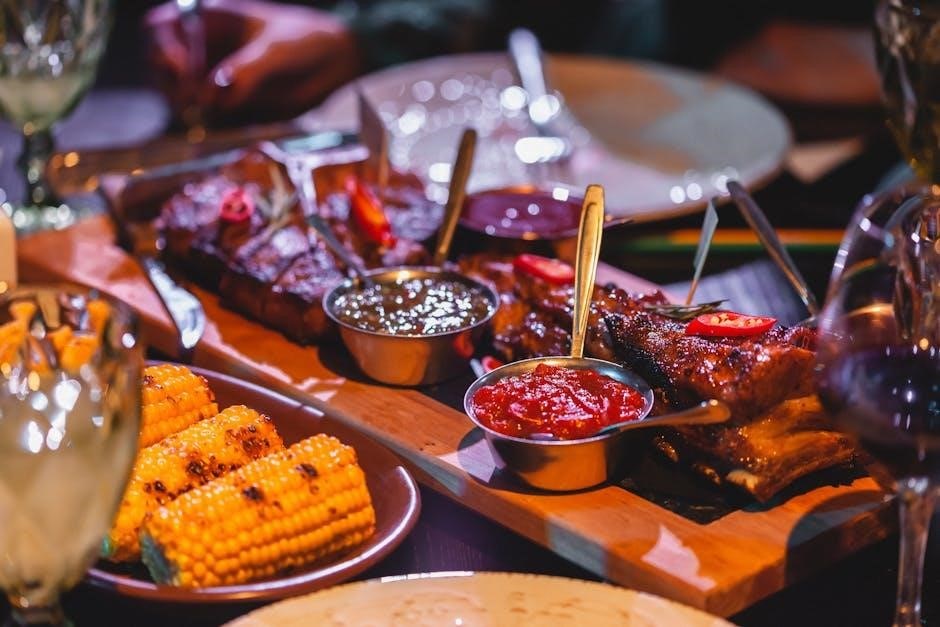
Common Mistakes to Avoid
Avoid overcooking pre-cooked prime rib‚ as it can become dry and tough․ Incorrect temperature settings and neglecting to rest the meat are frequent errors that compromise quality and texture․
Overcooking and Undercooking Scenarios
Overcooking pre-cooked prime rib can result in a dry‚ tough texture‚ while undercooking may leave it too rare or unevenly heated․ Both scenarios arise from improper temperature control or neglecting to monitor the reheating process․ Overcooking often occurs when the meat is exposed to high heat for too long‚ stripping it of natural juices․ Undercooking‚ on the other hand‚ can happen if the prime rib isn’t heated thoroughly‚ especially in thicker areas․ To avoid these issues‚ use a meat thermometer to ensure the internal temperature reaches a safe minimum of 145°F (63°C) for medium-rare․ Always follow reheating instructions carefully to achieve the perfect doneness․
Incorrect Temperature Settings
Incorrect temperature settings can significantly impact the quality of pre-cooked prime rib․ Using too high a temperature can cause the exterior to dry out before the interior is properly heated‚ leading to an uneven texture․ Conversely‚ too low a temperature may result in slow‚ inefficient reheating‚ potentially leaving the meat undercooked in some areas․ To avoid these issues‚ always follow the recommended temperature guidelines for your reheating method‚ typically between 300°F and 350°F for oven reheating․ Using a meat thermometer to monitor the internal temperature ensures it reaches a safe minimum of 145°F for medium-rare‚ preventing overcooking or undercooking scenarios․

Troubleshooting
Troubleshooting common issues with pre-cooked prime rib ensures a perfect dining experience․ Addressing problems like drying out or uneven heating can be resolved with proper techniques and tools․
Fixing Overcooked Prime Rib
If your pre-cooked prime rib becomes overcooked‚ there are ways to salvage it․ Slice the meat thinly against the grain to make it more tender․ Use a marinade or sauce to add moisture and flavor․ For a dry texture‚ try placing the prime rib in a slow cooker with broth or au jus on low heat for 30 minutes to rehydrate it․ Resting the meat before serving can also help redistribute juices․ These methods can transform an overcooked prime rib into a delicious‚ juicy dish‚ ensuring your meal remains enjoyable despite the mishap․
Adjusting Seasoning and Flavor
Adjusting the seasoning and flavor of pre-cooked prime rib is straightforward․ Start by tasting the meat to identify what it needs—more salt‚ pepper‚ or herbs․ For a savory boost‚ rub the prime rib with a mix of garlic powder‚ paprika‚ and dried herbs like thyme or rosemary․ If it lacks moisture‚ brush it with au jus or beef broth during reheating․ For a tangy twist‚ glaze it with a mixture of butter‚ horseradish‚ and Dijon mustard․ Resting the meat after reheating allows the flavors to meld․ Experiment with these techniques to enhance the taste and ensure a delicious‚ well-seasoned dish every time․
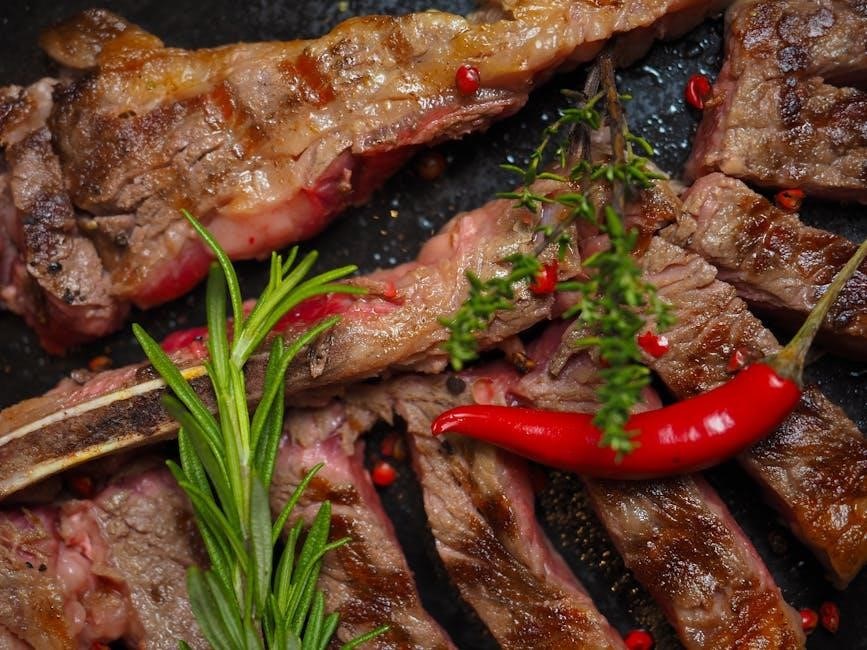
Pre-cooked prime rib offers convenience and flavor‚ perfect for busy households․ With proper reheating and seasoning‚ it delivers a delicious‚ stress-free dining experience every time․
Final Tips for a Perfect Pre-Cooked Prime Rib
For a flawless pre-cooked prime rib‚ ensure even reheating to avoid overcooking․ Let the meat rest before slicing to retain juices․ Enhance flavor by seasoning generously and allowing it to sit before reheating․ Use au jus for added moisture and richness․ Experiment with glazes or rubs for a personalized touch․ Pair with complementary sides like roasted vegetables or creamy sauces for a well-rounded meal․ By following these tips‚ you’ll achieve a tender‚ flavorful prime rib that impresses every time‚ making it a stress-free yet satisfying centerpiece for any occasion․